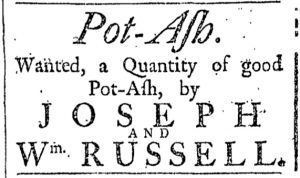GUEST CURATOR: Matt Ringstaff
What was advertised in a colonial American newspaper 250 years ago this week?

“Wanted, a Quantity of good Pot-Ash.”
Before seeing the word “Pot-Ash” in Joseph and William Russell’s advertisement from 1769 in the Providence Gazette I had no idea what is was or what it was used for. I understood from the advertisement was that there was a large market for it. Potash, “a crude form of potassium carbonate,” came from the ashes of burned trees. Colonists originally used it for making soap and, later, gunpowder. According to William E. Burns, colonists used small amounts of potash for baking to help cakes rise. Colonists made potash “by burning logs and other wood to ashes, then placing the ashes in a barrel lined with twigs and straw.” After that step, “[p]otash makers poured water on top of the ashes, dissolving out the salts.” Then they boiled what was left to create potassium carbonate that “made up less than a quarter of the mass.” Potash had many uses in colonial times, “from household soapmaking to glass manufacture.”[1]
**********
ADDITIONAL COMMENTARY: Carl Robert Keyes
Sometimes when guest curators examine the featured advertisements I instead choose to comment more extensively on methodology, pedagogy, or the benefits and challenges of working with digitized primary sources. For this entry, I offer a few comments on Assumption College’s twenty-fifth annual Undergraduate Symposium.
Today all of the guest curators that have worked on the project this spring will make presentations about their contributions at the Symposium, sharing their work beyond the classroom in yet another forum. Designed to replicate a conference, the Symposium draws together talented undergraduate students from across the many departments on campus. Students may make oral presentations or participate in poster sessions, whichever best fits their projects and matches the practices in their disciplines.
The guest curators for the Adverts 250 Project, all of them History majors enrolled in my upper-level Revolutionary America class, will make presentations that they have previously delivered in class in preparation for the Symposium. I oversaw a workshop for each presentation. The entire class discussed what worked well and offered constructive suggestions for improvement so each guest curator could make the necessary revisions and deliver a polished presentation at the Symposium.
The ten presentations related to the Adverts 250 Project have been divided into two sessions of five presentations each. A faculty moderator from the Symposium Committee will oversee each session. I will make a formal introduction for each young scholar. Then each will make a ten-minute presentation, followed by five minutes for questions and discussion. Later in the day everyone involved in the Symposium will gather at a reception hosted by the Provost and the Symposium Committee to celebrate their accomplishments.
Preparing for and participating in the Symposium requires a lot of time. In my Revolutionary America class, we have given over three of twenty-seven class meetings to this endeavor. This means that we cover less content in the course of the semester, but I know from experience that students ultimately learn the content we do cover much better because it has been linked to other skills they have developed and honed as part of the Adverts 250 Project. From History Labs in class to the Symposium near the end of the semester, the guest curators have enhanced their information literacy, expanded their research skills, refined their writing abilities, and gained valuable experience with public speaking. All of these will serve them well in their future studies and, more significantly, beyond the classroom.
Good luck at the Symposium today, guest curators!
**********
[1] William E. Burns, Science and Technology in Colonial America (Westport, CT: Greenwood Press, 2005), 25.

[…] Both would have been familiar to regular readers of the Providence Gazette, having appeared the previous week and in earlier issues. As a result, these “Advices” may have seemed less pressing than the […]